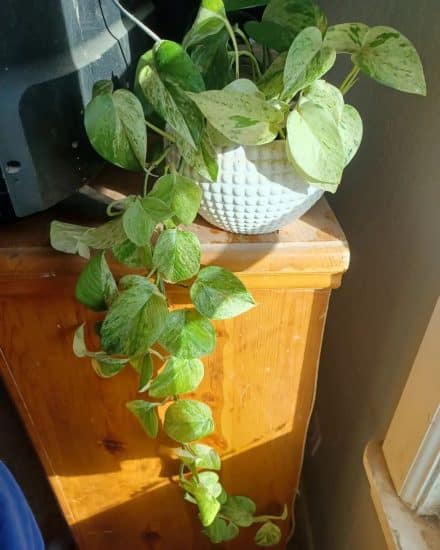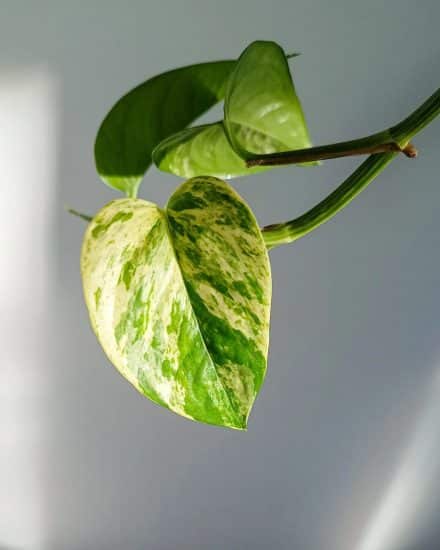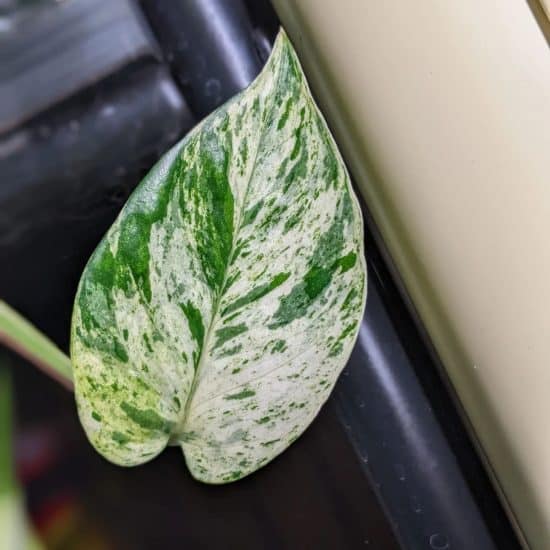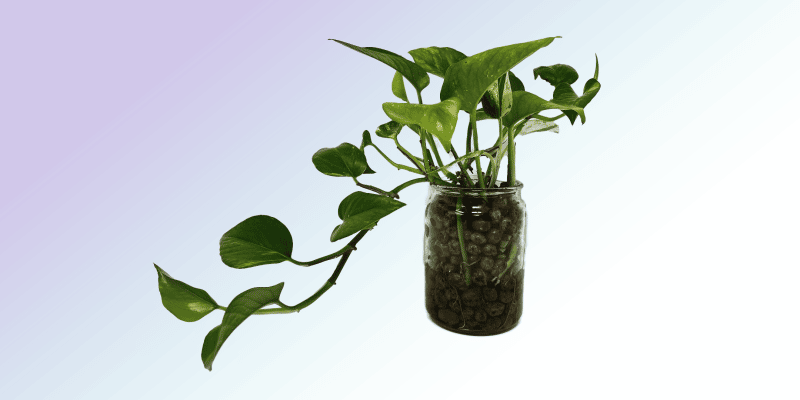Marble queen pothos is a fast-growing, low-maintenance plant with a choose-your-own style of growth—it looks fabulous climbing up a moss pole or trailing from a hanging basket or planter. The leaves of the marble pothos feature attractive variegation with cream and green hues.
It may resemble the golden and snow queen pothos, but marble pothos is a variety all its own. Since it’s both cold-hardy and able to thrive in tricky low-light conditions, the marble queen pothos is an ideal houseplant for low-maintenance care.
We’ll cover propagation, the most common issues (like yellowing leaves or loss of variegation), and how to care for this versatile climbing plant.
Table of Contents
Marble Queen Pothos Care Guide
History, habitat, and characteristics

The Marble Queen Pothos (Epipremnum aureum ‘Marble Queen,’) is a unique climbing or trailing tropical plant with marbled silver, yellow, and green leaves, making it an eye-catching addition to any indoor living space. This tropical vine is native to Southeast Asia (specifically French Polynesia on the island of Moorea), and was first described in 1880. However, it has since become a popular houseplant in many countries around the world.
Unlike its relative, the Manjula Pothos, the Marble Queen has strong stems and large clusters of arrow or heart-shaped leaves. Its leaves are glossy and variegated, boasting a vibrant green color with cream markings. Although the plant will sometimes produce small, dull flowers, the leaves are really the star of the show here.
Given the right conditions, Marble Queen Pothos grows incredibly quickly. As indoor plants, they can grow up to 3 feet wide and 10 feet tall. And get this: they can reach a length of up to 65 feet in their natural environment! This is why they have the nickname devil’s ivy or devil’s vine. In fact, in some geographic areas, they are viewed as invasive, so you should take care to bag up any cuttings before tossing them (not that you would resist a chance to propagate, right?).

Variants
There are dozens of pothos varieties. Although marble queen pothos care isn’t difficult, some of its fellow pothos are a bit more picky.
- Golden pothos. Marble queen pothos closely resembles Golden pothos, which features variegated yellow leaves as opposed to the marble queen’s white.
- Snow queen pothos. Marble queen pothos also resembles the Snow Queen pothos. However, the snow queen pothos has pointier leaves and is generally fussier about its environment.
- Neon pothos. Marble pothos could never be mistaken for the bright green Neon pothos, but their leaf shapes are similar.
- Other common pothos plants variants include Manjula, Cebu Blue, Njoy, Hawaiian, Jade, Silver, and Jade pothos, each with their own individual characteristics and charm.
Light

When it comes to light requirements, marble queen pothos is quite forgiving. For the prettiest variegation and quickest foliage growth, place it near a window that gets bright, indirect light to mimic the dappled sunlight of its native habitats. The marble pothos will also flourish in slight shade and some morning sun; however, direct sunlight should be avoided, as it may cause the foliage to dry out and burn.
While the marble pothos can tolerate low light conditions, its variegation is affected by the level of light it receives. Too little light causes the plant to become overly green as it seeks to increase photosynthesis, and too much direct sunlight will cause the cream color of the leaves to fade, as it photosynthesizes too much. To ensure the variegation stays prominent, the marble pothos requires medium to bright indirect light.
If your marble queen plant isn’t getting enough natural light, a bright artificial light is recommended. If a grow light is necessary, select one that provides a full spectrum, with a warm spectrum of 2700K being the most ideal but feel free to match to your existing interior lighting warmth.
Water
Instead of watering Marble Queen on a set schedule, use the tried-and-true finger in soil method. Stick a finger one or two inches deep into the soil. If it’s moist, no need to water just yet. If it’s dry, time to water generously.
When watering in most situations, once every one to two weeks will be sufficient. Although marble pothos is drought tolerant and prefers dry soil to sopping, if your plant is kept in a dry or warm environment, you may need to water it more frequently.
In the winter, the marble queen pothos plant will need to be watered less often. Be careful not to overwater, since this can result in excess soil moisture, allowing water to pool around your plant’s roots and cause roots to rot.
Tap water is generally fine for this plant, though if you detect a salt build-up around the leaves, it may be worth experimenting with filtered water or bottled water to avoid salt or chemical burn.
Temperature and humidity
Like most pothos plants, the Marble pothos is most content with moderate temperatures between 65-80 degrees Fahrenheit. In terms of humidity, they prefer higher levels of up to 60%, but will grow well in typical household humidity between 40-60%.
If you want to create a more humid environment for your marble queen pothos, here are a few solutions:
- Place them close to other plants, as this will increase natural humidity (the process is called transpiration)
- Put them in the bathroom, as the steam from showers will raise the humidity
- Place them on top of a tray of pebbles and water, as the water will release moisture into the air
- Mist them regularly, as this will temporarily increase the amount of moisture in the air
Soil and planting
Marble queen pothos grows best in a slightly acidic soil blend, with a pH of anywhere from 6.1 to 7.3. For optimal results, use a well-draining soil mixture containing:
- At least 40% sphagnum moss or peat
- 20% loam
- 20% bark or compost
- 20% perlite
This potting soil combination provides the pothos plant with the aeration, drainage, and nutrient requirements it needs to thrive. If you want to both add increase water retention and drainage, consider adding some coco coir to the mix. It’s more sustainable than peat moss and prevents soil from getting too soggy, while still remaining most.
Repotting
Since the marble queen is a fast-growing plant, it will need to repotted at least once a year, preferably in the growing months. When it’s time to repot the Marble Queen Pothos, opt for a rectangular-shaped planter with enough drainage holes that allow ample room for the roots to spread for optimum plant growth. To further support root health, place a layer of gravel or rocks on the bottom above the pot’s drainage holes before adding the soil mix.
Fertilizing
While fertilizing marble queen pothos plant isn’t a must, using a 50% diluted balanced liquid fertilizer every two weeks during spring and summer helps to keep its soil nourished and healthy. It does not require fertilization during the winter.
If transferring your devil’s ivy to water, prune out any rotten roots before placing the plant in the water and use a diluted liquid fertilizer once a month to provide essential nutrients. Take care not to fertilize at full strength or too frequently, however, since this can cause your plant to suffer burns.
Pruning
Like other pothos plants, marble queen doesn’t strictly need to be pruned unless you’re removing dead or dying leaves. However, trimming its long vines every couple of months helps give it a bushy and full appearance. Plus, you can use stem tip clippings to start new plants!
Speaking of stem clippings, now that you’re familiar with the optimal environment for your queen pothos, let’s move on to propagate this beautiful specimen.
Propagation guide
Propagating a marble queen pothos through stem cuttings is easy, rewarding, and free. All you need is a glass jar, clean water, and a healthy stem cutting. You can also use the spaghnum moss air layering method, although this requires slightly more effort.
To propagate a marble queen pothos by stem cuttings:
- Cut a 4-6 inch section of stem from the pothos plant, making sure to include at least 4 nodes (the bumps from which new leaves grow), and 5 if possible.
- Remove the bottom leaves to expose the nodes, while leaving at least two leaves on top.
- Place the cutting in a glass jar filled with clean water, making sure that the nodes are submerged, but the leaves should remain above the water.
- Place the jar in indirect sunlight for 2-3 weeks.
- Once roots appear and are a few inches long, you can transport your new baby Marble Queen (Marble Princess?).
- You can move your cutting to the same pot as the mother plant or to its own pot. Either way, gently pat down the soil around the main stem, then place in medium to bright indirect lighting and keep the soil moist.
To propagate marble queen pothos by air layering sphagnum moss:
- Place sphagnum moss in a bowl full of water. Squeeze it to let excess water drain.
- Carefully wrap the moss around your plant’s stem.
- Cover the moss and stem thoroughly with plastic, which will keep the stem moist. It should grow roots in a few weeks.Tip: If the moss begins to dry out, unwrap the plastic, mist it the moss and stem, and then wrap it all back up again.
- Once the roots have grown to several inches, cut the stem and put it in soil (either with the same plant it spawned from or another pot). The larger the roots are when replanted, the more water they will absorb once potted, which gives your pothos better odds of thriving.
Congratulations, you’ve now successfully propagated your marble queen pothos! Now we’ll move on to some common issues your plant might face, like brown leaves or spider mites, and how to solve them.
Common issues

- Dry, brown, leaf edges/droopy leaves. Leaf tips and edges can turn brown, and leaves can droop, from insufficient watering.
- Yellowing leaves. If your plant has yellow leaves and its soil is soggy, this could be a result of overwatering. If leaves are yellow and the soil is dry, it could be getting too little light.
- Leaves solid green. If your pothos has solid green leaves, your plant isn’t getting enough light and should be moved to a brighter spot to ensure it thrives.
- Leaves too light. If your plant’s creamy leaf spots are fading, it’s getting too much light and should be moved to a shadier location.
- Dark patches on leaves. This is likely a result of the temperature being too low. Remove the damaged leaves and move the plant to a warmer spot.
- Leggy stems. Growing in low light can lead to leggy stems. Prune them back in the spring for a bushier appearance and move your plant to a location with more light.
- Stunted growth. Marble Queen Pothos might develop nutrient deficiencies from poor soil. Stunted growth and yellowing foliage are indicators of this, which can be addressed with a general-purpose fertilizer every two weeks.
Let’s move on to the diseases and pests your plant is prone to and how to nip them in the bud.
Diseases and pests
When caring for your Marble Queen pothos, it’s important to watch out for both diseases and pests, and act quickly at the first sign of either. Make sure to isolate your plant while you solve these issues so that they don’t spread to any others. And after you’ve resolved the acute problem, make sure you understand what weakened the plant in the first place.
Root rot
Pythium root rot is a common disease in pothos plants, caused by a fungus due to overwatering. Its symptoms include yellow or brown leaves, as well as necrotic dark spots on the plant’s base. If you think your pothos might have root rot, you should remove the affected roots and repot your plant in fresh potting soil.
Pests
Pests such as aphids, mealybugs, spider mites, and scale insects, can suck sap out of your plant’s leaves, leading to yellow or brown leaves and leaf death. To get rid of these unwanted insects, wash your marble queen’s leaves using an organic insecticidal soap or neem oil.
Isolate the plant for up to a week after there are no signs of insects to prevent infestation of other plants from hatching eggs.
Conclusion
One of the easiest tropical plants to take care of, the marble pothos features gorgeous leaf variegation and is able to thrive when exposed to a range of lighting conditions. A medium level of bright indirect sunlight is ideal for a Marble Queen Pothos, but the plant can adapt to either low or high light conditions. Moderate household humidity and temperature work well for this plant, as does a slightly acidic, well-draining soil mix.
While marble pothos maintenance is simple, careful observation of the leaves is essential: limp leaves and brown, dry edges are signs of underwatering, whereas yellowed leaves with soggy soil indicate overwatering.
Marble queen is easy to grow and a delight for the eyes. Propagate your plants via sphagnum moss or stem cutting and give them as gifts to wow your friends even if they aren’t great at keeping plants. The Marble Queen is pretty forgiving.
FAQ
How rare is a Marble Queen pothos?
Marble queen pothos plants are one of the most common types of plants, so you should have luck finding them at your local garden center.
Why is my pothos marbling?
Given the right amount of light, marble queen pothos plants sport variegated leaves with creamy splotches. It’s part of their natural growth process and what makes them so alluring.
Are Marble Queen pothos hard to take care of?
Since they quickly adapt to varying light conditions, including low light and direct sun, marble queen pothos care is about as easy as it gets.
Should I mist my Marble Queen pothos?
You can mist your marble queen pothos to temporarily increase its humidity level, but this isn’t the most effective way to raise humidity for the long term. If your plant has brown leaf tips or requires a more humid environment, consider using a humidifier or pebble tray.
Is Marble Queen Pothos toxic?
Like all pothos, marble queen is toxic to pets because its stem and leaves contain calcium oxalate crystals. Keep it in a different room or at a height away from any curious cats or dogs.


